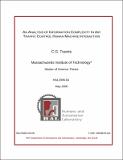An Analysis of Information Complexity in Air Traffic Control Human Machine Interaction
Author(s)
Tsonis, C. G.
DownloadHAL2006-04.pdf (1.697Mb)
Other Contributors
Massachusetts Institute of Technology. Dept. of Aeronautics and Astronautics. Humans and Automation Laboratory
Metadata
Show full item recordAbstract
This thesis proposes, develops and validates a methodology to quantify the complexity of air traffic control (ATC) human-machine interaction (HMI). Within this context, complexity is defined as the minimum amount of information required to describe the human machine interaction process in some fixed description language and chosen level of detail. The methodology elicits human information processing via cognitive task analysis (CTA) and expresses the HMI process algorithmically as a cognitive interaction algorithm (CIA). The CIA is comprised of multiple functions which formally describe each of the interaction processes required to complete a nominal set of tasks using a certain machine interface. Complexities of competing interface and task configurations are estimated by weighted summations of the compressed information content of the associated CIA functions. This information compression removes descriptive redundancy and approximates the minimum description length (MDL) of the CIA. The methodology is applied to a representative en-route ATC task and interface, and the complexity measures are compared to performance results obtained experimentally by human-in-the-loop simulations. It is found that the proposed complexity analysis methodology and resulting complexity metrics are able to predict trends in operator performance and workload. This methodology would allow designers and evaluators of human supervisory control (HSC) interfaces the ability to conduct complexity analyses and use complexity measures to more objectively select between competing interface and task configurations. Such a method could complement subjective interface evaluations, and reduce the amount of costly experimental testing.
Date issued
2006Publisher
HAL Humans and Automation Laboratory
Series/Report no.
HAL Reports;HAL2006-04